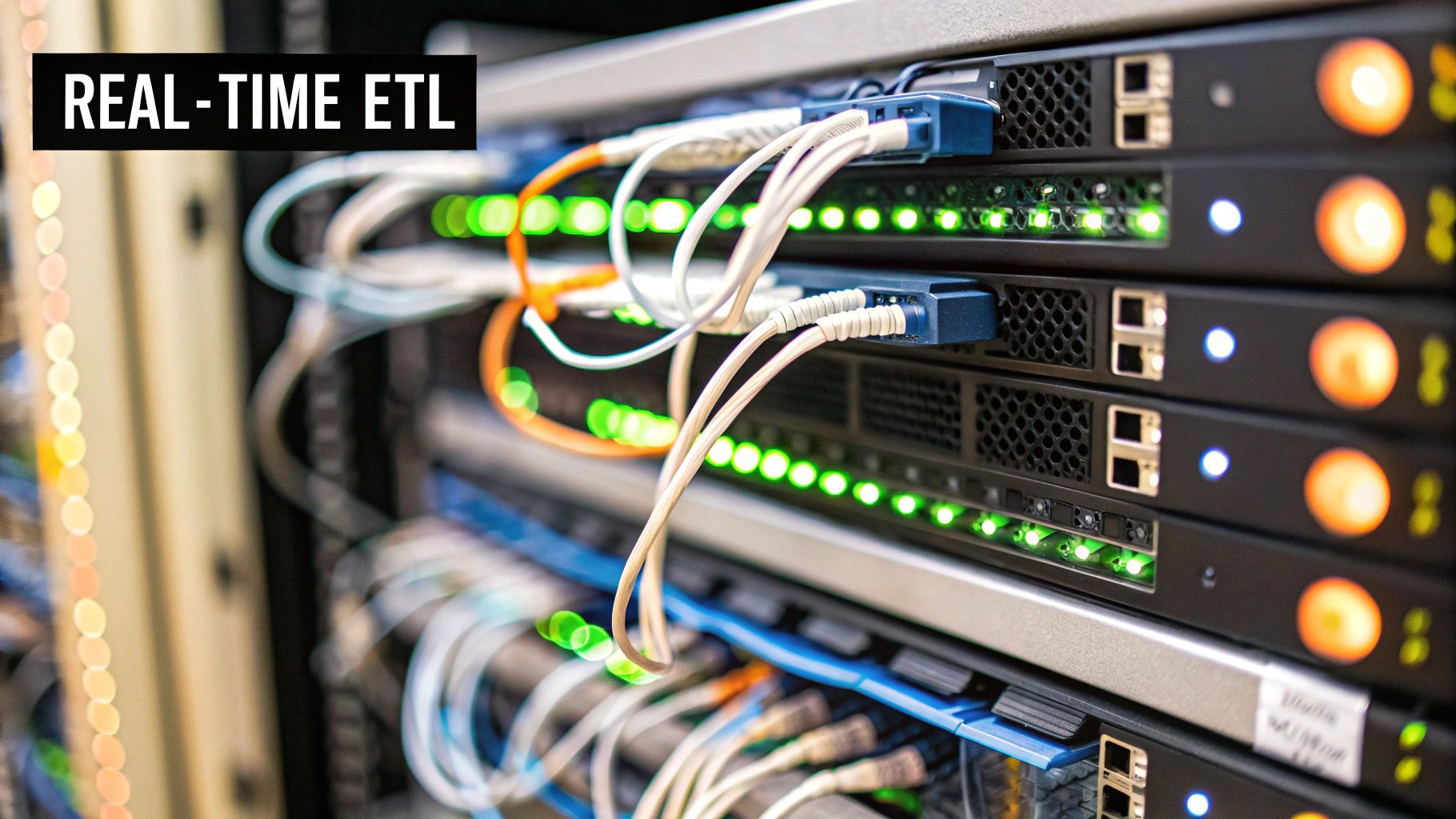Data Integration Best Practices: Boost Efficiency & Scalability
In today's B2B and SaaS landscape, data is the engine of growth. But disconnected systems and messy data flows can sabotage your scalability, leading to missed opportunities and flawed decision-making. Effective data integration is no longer just a technical task; it is a strategic imperative that separates industry leaders from the laggards. When your CRM, marketing platform, and financial systems operate in silos, you're flying blind.
A robust integration strategy ensures your sales team has accurate lead data, your marketing efforts are informed by real customer behavior, and your leadership team gets a clear, unified view of business health. Moving beyond basic data dumps requires a disciplined approach. To truly transform your operations and ensure smooth data flow, a comprehensive understanding of foundational principles is essential. Explore these Data Integration Best Practices for Seamless Workflows to build a solid base for your strategy.
This article cuts through the noise to provide a clear roadmap. We will break down the nine essential data integration best practices crucial for streamlining operations and building a foundation for sustainable growth. Forget generic advice; we're diving into actionable steps, real-world examples, and specific tools you can use to build a truly connected enterprise. Let’s get started.
1. Data Profiling and Quality Assessment
Data profiling is the foundational first step in any successful data integration project. It involves a systematic analysis of source data to gain a deep understanding of its structure, content, and overall quality before you even begin the integration process. This proactive measure prevents the classic "garbage in, garbage out" scenario by identifying potential issues early.

Think of it as performing a health check on your data. You'll examine data patterns, identify anomalies like missing values or incorrect formats, and assess completeness. This initial analysis ensures that the data you're integrating is reliable, accurate, and fit for its intended purpose, making it one of the most critical data integration best practices.
Why It's a Foundational Practice
Skipping this step is like building a house without inspecting the foundation. You risk costly downstream errors, failed integrations, and business decisions based on flawed information. For instance, a bank merging systems during an acquisition must profile customer data to resolve duplicate records and inconsistent address formats beforehand. Similarly, healthcare providers profile patient records to ensure data integrity before migrating to a new electronic health record (EHR) system.
Actionable Implementation Tips
- Start Early: Begin profiling as soon as source data is identified, well before integration development starts. This gives you ample time to address any discovered issues.
- Leverage Automation: Use tools like Informatica, Talend, or SAS Data Management to efficiently analyze large datasets. Manual profiling is not scalable or comprehensive enough for modern data volumes. For unstructured sources, understanding concepts like intelligent document processing can be highly beneficial.
- Involve Stakeholders: Collaborate with business users who understand the data's context. They can help validate profiling findings and determine what constitutes an "anomaly" versus a valid data variation.
- Document Everything: Maintain a detailed record of your findings, including data types, null value percentages, and identified quality issues. This documentation is invaluable for developers and future data governance efforts.
2. Standardized Data Modeling and Schema Design
Once you understand your data's quality, the next step is to create a unified blueprint for it. Standardized data modeling involves designing consistent schemas and structures that act as a common language for all your systems. This practice establishes uniform data formats, naming conventions, and relationships, ensuring that data flows seamlessly and retains its meaning across the organization.

Think of it as creating a universal adapter for your data sources. By defining a target model, you create a stable, predictable foundation that simplifies development, reduces translation errors, and makes the entire integration process more manageable. This proactive design is a core pillar of effective data integration best practices.
Why It's a Foundational Practice
Without a standard model, each integration becomes a custom, one-off project. Developers must constantly translate between different schemas, leading to inconsistencies, increased complexity, and a brittle architecture that is difficult to maintain. For example, Walmart standardizes its product catalog schema across global subsidiaries to ensure consistent reporting and inventory management. Similarly, Spotify uses a unified metadata schema so that a song’s artist, album, and genre information appears identically across its web, mobile, and desktop platforms.
Actionable Implementation Tips
- Involve Business Stakeholders: Collaborate with business teams to ensure the schema accurately reflects business concepts and terminology. Their input is crucial for designing a model that is both technically sound and contextually relevant.
- Plan for Scalability: Design your data models with future needs in mind. Consider how new data sources, attributes, or business requirements might impact the structure and build in flexibility from the start.
- Use Industry Standards: Where possible, adopt industry-standard formats like JSON Schema for APIs or common data models relevant to your sector (e.g., NIEM for government agencies). This improves interoperability with third-party systems.
- Implement Schema Versioning: Treat your schema like code by implementing version control. This allows you to manage changes systematically and track the evolution of your data model over time without breaking existing integrations.
3. Incremental and Real-time Data Processing
Instead of reprocessing entire datasets with every cycle, modern data integration focuses on processing only new or changed data. This approach, encompassing both incremental batch updates and real-time streaming, ensures data freshness while significantly reducing system load and resource consumption. It's the difference between reading an entire book again versus just reading the new chapter.

This method is crucial for use cases where timely information is a competitive advantage. By processing data as it’s generated, organizations can react instantly to events, a key tenet of effective data integration best practices. This allows for dynamic pricing, instant fraud detection, and up-to-the-minute inventory management.
Why It's a Foundational Practice
Processing full datasets repeatedly is inefficient, expensive, and slow. As data volumes grow, this approach becomes unsustainable. For instance, financial institutions rely on real-time transaction streaming to detect and block fraudulent activity in milliseconds. Likewise, e-commerce giants like Amazon update inventory levels in real-time across all channels to prevent overselling popular items. This practice moves data from a historical record to a live, actionable asset.
Actionable Implementation Tips
- Implement Change Data Capture (CDC): Use CDC tools or database features to efficiently identify and capture inserts, updates, and deletes from source systems without impacting their performance.
- Design for Idempotency: Ensure your processing logic can handle duplicate records without causing errors or data corruption. This is critical for building resilient systems that can recover from failures.
- Use Message Queues: Leverage technologies like Apache Kafka or RabbitMQ to create a reliable, scalable buffer for streaming data. This decouples data producers from consumers and prevents data loss.
- Monitor Data Lag: Continuously track the time delay between when an event occurs and when it is processed. This helps you maintain service level agreements (SLAs) for data freshness.
4. Comprehensive Error Handling and Data Validation
Effective data integration is not just about moving data; it's about moving correct data reliably. Comprehensive error handling and data validation form the safety net of your integration pipeline, providing a systematic approach to identifying, managing, and recovering from issues. This involves implementing rules and automated checks to ensure data integrity and system resilience when errors inevitably occur.

Think of this as an automated quality control system. It catches problems like incorrect data types, missing required fields, or values that fall outside acceptable ranges before they can corrupt the target system. A robust validation framework is a non-negotiable component of modern data integration best practices, safeguarding the accuracy of your business intelligence and operational processes.
Why It's a Foundational Practice
Without a solid error-handling strategy, data pipelines are brittle and untrustworthy. A single malformed record could halt an entire batch process or, worse, silently introduce bad data into a critical system, leading to flawed analytics and poor decision-making. For instance, a supply chain system must validate inventory data for consistency across warehouses to prevent stockouts or overstock situations. Similarly, financial platforms like PayPal implement multi-layered validation to ensure transaction integrity and prevent fraud.
Actionable Implementation Tips
- Validate at Multiple Stages: Implement validation checks upon data extraction, during transformation, and before loading into the target system. This layered approach catches errors as early as possible.
- Create Clear Escalation Paths: Define procedures for different error types. Some errors might require automated retries, while others may need to be quarantined in a "dead letter queue" for manual review by a data steward.
- Use a Business Rules Engine: For complex validation logic that changes frequently (e.g., regulatory compliance checks), use a dedicated rules engine. This separates the logic from the integration code, making it easier to update.
- Provide Meaningful Error Messages: Log descriptive error messages that include the record ID, the field in error, the invalid value, and the specific rule that failed. This drastically simplifies troubleshooting for developers and support teams.
5. Robust Security and Access Control Implementation
Implementing robust security is not an optional add-on; it's a core component of any data integration strategy. This practice involves embedding comprehensive security measures throughout the entire data pipeline, including strong encryption for data in transit and at rest, multi-factor authentication, and granular authorization controls. It ensures that sensitive data is shielded from unauthorized access and cyber threats at every stage.
Think of it as building a digital fortress around your data flows. Every connection, every API call, and every database interaction must be secured. This proactive approach not only protects valuable information but also ensures compliance with regulations like GDPR, HIPAA, and PCI DSS, making it a non-negotiable part of modern data integration best practices.
Why It's a Foundational Practice
A security breach in your integration pipeline can have catastrophic consequences, including data theft, financial loss, and severe reputational damage. For example, a financial services firm must secure payment data flows to maintain PCI DSS compliance and protect customer trust. Similarly, a healthcare provider integrating patient records between a lab and a hospital must enforce strict access controls and end-to-end encryption to meet HIPAA requirements, preventing sensitive health information from being exposed.
Actionable Implementation Tips
- Adopt a "Security by Design" Approach: Integrate security considerations from the very beginning of the project, not as an afterthought. This means planning for encryption, access roles, and threat modeling during the initial design phase.
- Implement Principle of Least Privilege (PoLP): Grant integration processes and users the absolute minimum level of access required to perform their functions. Avoid using overly permissive service accounts.
- Leverage Encryption Everywhere: Use strong encryption protocols like TLS 1.2 or higher for data in transit and robust algorithms like AES-256 for data at rest in databases and storage systems.
- Conduct Regular Security Audits: Periodically test your integration security controls through penetration testing and vulnerability scans. Use established frameworks like the NIST Cybersecurity Framework as a guide for comprehensive security management.
6. Scalable Architecture and Performance Optimization
A scalable architecture is the blueprint for a data integration system designed to grow. It involves creating a framework that can handle increasing data volumes, more complex processing, and higher user demand without collapsing. This forward-thinking approach ensures that your integration workflows remain efficient and reliable as your business expands, preventing performance bottlenecks from stifling growth.
Think of it as building a highway with extra lanes already planned. As traffic (data) increases, you can open new lanes without having to rebuild the entire road. This is a core tenet of modern data integration best practices, shifting focus from a one-time setup to a dynamic, future-proof system.
Why It's a Foundational Practice
An architecture that cannot scale is a dead end. As data sources multiply and volumes explode, a rigid system will slow down, leading to delays in reporting, failed processes, and frustrated users. For example, a fast-growing e-commerce platform like Amazon must design its product catalog integration to handle millions of daily updates from vendors worldwide. Without a scalable architecture, the system would fail, impacting sales and customer experience.
Actionable Implementation Tips
- Design for Horizontal Scaling: From the outset, architect your system to scale horizontally by adding more machines to a cluster. This is often more cost-effective and flexible than vertically scaling (upgrading a single server).
- Implement Comprehensive Monitoring: Use performance monitoring tools to track key metrics like data throughput, latency, and resource utilization. This allows you to proactively identify and address performance issues before they become critical.
- Use Distributed Computing Frameworks: For processing large datasets, leverage frameworks like Apache Spark or Hadoop. These tools are specifically designed to distribute workloads across multiple nodes, enabling massive parallel processing.
- Optimize Data Access: Fine-tune database queries, use appropriate indexing, and implement caching strategies to reduce data retrieval times. Efficient data access is crucial for minimizing latency in integration pipelines.
7. Comprehensive Monitoring, Logging, and Alerting
Effective data integration doesn't end once the pipelines are running; it requires continuous oversight. A systematic approach to monitoring, logging, and alerting provides crucial visibility into the health and performance of your integration processes. This practice ensures you can proactively detect, diagnose, and resolve issues before they impact business operations.
Think of it as the mission control for your data pipelines. Detailed logs capture every event, monitoring tools track performance metrics in real-time, and automated alerts notify the right teams when anomalies occur. This framework transforms your integration from a "black box" into a transparent, manageable system, making it an essential component of modern data integration best practices.
Why It's a Foundational Practice
Without robust observability, integration failures can go unnoticed for hours or even days, leading to data corruption, incomplete datasets, and poor business decisions. For example, a logistics company must constantly monitor its package tracking data integration to ensure real-time updates for customers. Similarly, financial institutions rely on alerts to immediately flag failures in transaction processing pipelines to maintain regulatory compliance and prevent financial loss.
Actionable Implementation Tips
- Implement Structured Logging: Adopt a consistent logging format (like JSON) across all integration jobs. Include key details such as timestamps, job IDs, status codes, and error messages to make logs easily searchable and analyzable.
- Set Up Meaningful Alerts: Configure alerts based on business impact, not just technical failures. For instance, an alert for a pipeline that's running 50% slower than its baseline is more proactive than one that only triggers on a complete failure.
- Centralize with Log Aggregation Tools: Use platforms like Datadog, Splunk, or the ELK Stack (Elasticsearch, Logstash, Kibana) to consolidate logs from all sources. This provides a single pane of glass for monitoring and troubleshooting complex integration workflows.
- Create Operational Runbooks: Document standard procedures for responding to common alerts. A runbook should detail the issue, its potential causes, steps for diagnosis, and the resolution process, enabling faster and more consistent incident response.
8. Data Lineage and Impact Analysis Documentation
Data lineage is the practice of tracking the complete lifecycle of data, documenting its origin, movements, transformations, and final destinations. It creates a detailed map of the data flow, which is crucial for understanding dependencies and conducting impact analysis. This transparency is essential for troubleshooting, compliance, and maintaining trust in your data.
Think of it as a GPS for your data. When a report shows an unexpected number, data lineage allows you to trace its path back through every transformation and system to pinpoint the source of the error. This visibility is a cornerstone of effective data governance and one of the most important data integration best practices.
Why It's a Foundational Practice
Without clear lineage, making changes to your data pipelines is a high-risk activity. You can't confidently predict which downstream reports, applications, or business processes will be affected by a change in a source system. For instance, pharmaceutical companies rely on meticulous data lineage to track clinical trial data for FDA compliance. Similarly, financial institutions document data flows to prove regulatory adherence and quickly assess the impact of system updates.
Actionable Implementation Tips
- Automate Lineage Capture: Manually documenting data flow is error-prone and unsustainable. Use data integration tools with built-in lineage capabilities, such as Talend, Informatica, or dbt, to automate the capture process wherever possible.
- Integrate into Workflows: Embed lineage documentation into your development lifecycle. Just as developers document code, data engineers should document data flows as part of their standard process. This approach is similar to how teams practice mastering the documentation of requirements in Agile.
- Maintain Business and Technical Views: Create two layers of documentation. A technical view for developers showing table and column-level lineage, and a business-friendly view that explains the data flow in terms of business concepts and processes.
- Regularly Review and Validate: Data pipelines change. Schedule regular reviews to ensure your lineage documentation is still accurate and reflects the current state of your data architecture.
9. Automated Testing and Continuous Integration/Deployment
Adopting a software engineering mindset by implementing automated testing and Continuous Integration/Continuous Deployment (CI/CD) is essential for modern data pipelines. This practice involves creating automated tests for data transformations and end-to-end workflows, then integrating these tests into a deployment pipeline that automatically manages releases. This approach moves data integration from a manual, error-prone task to a reliable, repeatable, and scalable process.
Think of it as building a quality assurance factory for your data pipelines. Instead of manually checking data after each run, automated scripts validate transformations, check for schema changes, and verify data integrity at every stage. This systematic approach is a core component of data integration best practices, ensuring that any changes or updates do not break existing processes and that data remains trustworthy.
Why It's a Foundational Practice
In today's fast-paced environment, data pipelines are constantly evolving. Without automation, every minor change introduces significant risk, requiring extensive manual validation that slows down development and innovation. Financial institutions, for example, automate compliance checks in their trading data pipelines to ensure regulatory adherence without manual intervention. Similarly, tech giants like Netflix and Airbnb use CI/CD to rapidly and reliably deploy updates to the complex analytics pipelines that power their business decisions.
Actionable Implementation Tips
- Start with Critical Pipelines: Begin by applying automated testing to your most mission-critical data workflows. This ensures the highest-value processes are protected first, demonstrating immediate ROI.
- Implement Test Data Management: Create a strategy for generating or anonymizing realistic test data. Using production data for testing is often not feasible due to privacy and security concerns, so a dedicated test dataset is crucial.
- Use Infrastructure-as-Code (IaC): Define your testing and deployment environments using code (e.g., with Terraform or CloudFormation). This ensures that development, testing, and production environments are identical, eliminating "it works on my machine" issues.
- Integrate Testing into Developer Workflows: Embed automated tests directly into your version control system (like Git). This ensures tests are run automatically whenever a developer commits new code, catching errors instantly. Understanding how to automate business processes is key to building this type of integrated workflow.
Data Integration Best Practices Comparison
| Item | Implementation Complexity | Resource Requirements | Expected Outcomes | Ideal Use Cases | Key Advantages |
|---|---|---|---|---|---|
| Data Profiling and Quality Assessment | Moderate to High; requires specialized tools and expertise | Specialized software and skilled analysts | Improved data quality, reduced integration risks | Early-stage data understanding and integration planning | Enhances data reliability and compliance |
| Standardized Data Modeling and Schema Design | High; significant upfront planning and design | Cross-team collaboration and design tools | Consistent, reusable data structures | Large-scale system integrations needing standardization | Reduces complexity, improves data consistency |
| Incremental and Real-time Data Processing | High; complex change tracking and error handling | Advanced streaming technologies and monitoring | Near real-time data availability, optimized performance | Systems requiring fresh data and high throughput | Reduces processing time, supports rapid updates |
| Comprehensive Error Handling and Data Validation | Moderate to High; detailed rule creation | Validation frameworks and business knowledge | Maintained data integrity and system stability | Environments demanding high data accuracy and reliability | Prevents invalid data entry, supports compliance |
| Robust Security and Access Control Implementation | High; complex security architecture | Security expertise, encryption tools, ongoing management | Protected sensitive data, regulatory compliance | Sensitive or regulated data integrations | Protects data, ensures compliance |
| Scalable Architecture and Performance Optimization | High; requires architectural expertise and planning | Scalable infrastructure and monitoring tools | Consistent performance with growing data loads | Large, growing data environments requiring scalability | Efficient resource use, supports business growth |
| Comprehensive Monitoring, Logging, and Alerting | Moderate; requires monitoring setup and tuning | Logging platforms and alerting systems | Proactive issue detection and performance visibility | Critical systems needing uptime and auditability | Enables quick troubleshooting and audit support |
| Data Lineage and Impact Analysis Documentation | Moderate to High; ongoing maintenance needed | Lineage tools, governance processes | Improved change impact understanding and compliance | Highly regulated or complex data environments | Facilitates audits and troubleshooting |
| Automated Testing and Continuous Integration/Deployment | High; requires setup of tests and CI/CD pipelines | Testing frameworks, CI/CD tools, skilled teams | Reliable deployments, early issue detection | Agile and DevOps environments for data workflows | Reduces manual errors, speeds development cycle |
From Theory to Action: Automating Your Integration Strategy
Navigating the landscape of modern data is a journey from complexity to clarity. We've explored the essential pillars of a robust integration strategy, moving from initial Data Profiling and Quality Assessment to the sophisticated mechanics of Automated Testing and Continuous Deployment. Each practice, from Standardized Data Modeling to Comprehensive Error Handling, serves as a critical building block for creating a data ecosystem that is not just functional but truly transformative.
The core message is clear: successful data integration is not a one-time project. It is a continuous, evolving discipline that demands precision, foresight, and a commitment to quality at every stage. Implementing these data integration best practices ensures your architecture is resilient, your data is trustworthy, and your systems are prepared to scale alongside your ambition.
Turning Knowledge into Operational Excellence
Simply understanding these concepts is not enough. The true competitive advantage comes from embedding them into the DNA of your daily operations. Manually managing data validation, performance monitoring, and security protocols across dozens of interconnected systems is an inefficient and unsustainable approach that inevitably leads to errors and bottlenecks. The path forward lies in intelligent automation.
Here are the key takeaways to operationalize:
- Prioritize a Solid Foundation: Never skip the fundamentals. Rigorous data profiling, quality assessment, and standardized schema design prevent countless downstream issues and reduce technical debt.
- Embrace Proactive Management: Shift from a reactive to a proactive stance. Implement comprehensive monitoring, logging, and alerting to identify and resolve potential problems before they impact your business operations or customer experience.
- Build for Scale and Security: Your integration architecture must be built to grow. By focusing on scalable design patterns and enforcing robust security and access controls from day one, you create a framework that can support future innovation without compromise.
The Power of an Automated Framework
Mastering these data integration best practices is the first step toward building a resilient, scalable, and data-driven organization. The real power, however, is unlocked when you weave them together into an automated, self-sustaining framework. This is where theory meets action. Imagine CI/CD pipelines that automatically test and deploy your data workflows, ensuring reliability with every update. Picture a system where robust standard operating procedures (SOPs) are not just documented but actively enforced through automation, guaranteeing consistency and quality.
By automating the routine and codifying best practices, you eliminate the friction points that slow down innovation. Your team is liberated from the tedious, manual tasks of data wrangling and validation, allowing them to focus on what truly matters: deriving strategic insights, improving customer experiences, and driving business growth. An automated integration strategy doesn't just move data; it accelerates your entire organization.
Ready to transform your data integration strategy from a manual effort into an automated powerhouse? The team at MakeAutomation specializes in designing and implementing bespoke automation frameworks that operationalize these best practices, ensuring your data is always accurate, timely, and secure. Let MakeAutomation help you build an integration ecosystem that scales with your ambition.







